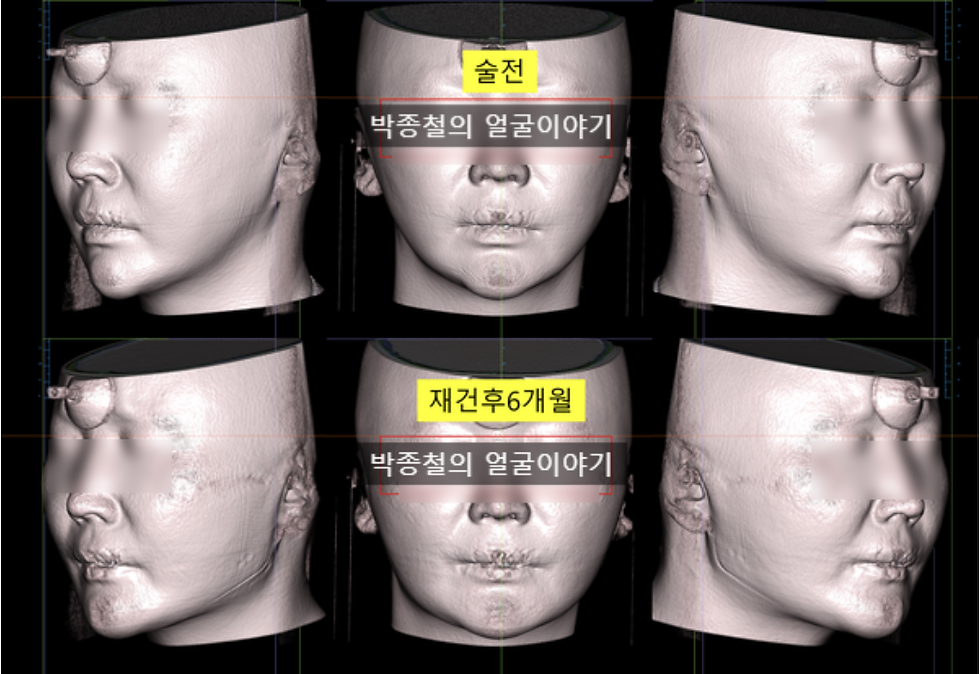Mandible and chin volume Restoration: A Case Study in Complex Facial Contouring Revision
- Dr. Park

- Nov 10
- 3 min read
Hello, I am Dr. Jong-chul Park, an Oral and Maxillofacial Surgeon.
With the increasing frequency of facial contouring surgery, the number of individuals considering facial contouring reconstruction due to aesthetic dissatisfaction or functional issues is also rising. Reconstruction surgery involves more variables than primary surgery and is considered a highly complex procedure.
Today, I will analyze a case of complex facial contouring restoration performed to resolve aesthetic dissatisfaction following a previous "3-kind facial contouring" (zygoma, mandible, chin) surgery, based on objective data.
This case, which involves a combination of zygoma repositioning, allograft bone grafting, custom titanium implants, and custom silicone implants, will be particularly informative for those considering comprehensive revision procedures, including Mandible and chin volume Restoration.
Patient Analysis and Reconstruction Goals
Pre-operative 3D CT and facial analysis revealed that while the chin was narrow, a "lateral depression" (hollowed appearance) was observed in the lateral chin area, causing a discontinuous jawline.
The patient wished to restore a more defined and voluminous contour to their mandible and zygoma areas.

Surgical Plan for Complex Mandible, chin, and Zygoma Reconstruction
Based on the patient's subjective requests and an objective analysis of their skeletal state via 3D CT, a complex facial contouring reconstruction was planned for all three areas.
1. Zygoma and Mandible Reconstruction Design
For the zygoma, a zygoma repositioning procedure was planned to move the bone outward. An allograft bone graft was planned concurrently to supplement the resulting gap and "step-off" deformity, aiming to create a natural volume.
For the mandible reconstruction, a custom-designed 3D titanium implant was planned to restore the previously resected area of the jawbone, reflecting the patient's aesthetic goals.

2. Genioplasty Reconstruction Design
After finalizing the mandible reconstruction designs, the genioplasty reconstruction was planned to balance the overall face. A custom silicone implant was designed for the chin to precisely augment the volume in the problematic lateral depression area.

6-Month Post-operative Results (Skeletal and Soft Tissue Comparison)
A 6-month post-operative 3D CT was taken to objectively compare the skeletal and soft tissue changes against the pre-operative state.
The titanium implant used for mandible reconstruction and the fixation status of the repositioned zygoma are clearly visible on the CT images. (Note: The silicone implant used for genioplasty reconstruction may not be clearly visible in standard CT settings due to its radiolucent properties.)

A comparison of soft tissue changes confirmed that the pre-operative lateral depression was improved. Furthermore, the volume in the mandible and zygoma areas increased naturally, in line with the patient's aesthetic requests.

Objective Data Analysis: Zygoma Restoration Volume
Objective data analysis is crucial for evaluating facial contouring reconstruction. To visualize the restoration, the 6-month post-operative soft tissue contour (yellow line) was superimposed on the pre-operative image.

Furthermore, we precisely measured the amount of bone movement and the corresponding soft tissue change using CT cross-sectional images:
Right Zygoma: 4.34mm bone movement / 3.40mm soft tissue expansion (78.34% projection)
Left Zygoma: 4.45mm bone movement / 3.75mm soft tissue expansion (84.26% projection)

[Clinical Point] The Role of Allograft in Zygoma Reconstruction
In cases like this facial contouring reconstruction, where zygoma repositioning is used to move the bone outward, gaps and "step-off deformities" between bone segments are inevitable.
To connect this area smoothly and naturally, an allograft was used to ensure bone continuity and induce stable, long-term bone fusion.

Conclusion: The Importance of a Composite Approach in Mandible and Genioplasty Reconstruction
This case demonstrates a simultaneous reconstruction of the zygoma (repositioning + allograft), mandible (titanium), and chin (silicone) using different materials and methods to resolve aesthetic dissatisfaction after a previous 3-kind contouring surgery.
When considering complex facial contouring reconstruction, including mandible, chin, and zygoma reconstruction, it is crucial to select the optimal materials (e.g., autograft, allograft, titanium, silicone) and surgical methods based on the patient's current skeletal state, soft tissue characteristics, and aesthetic needs. Above all, precise planning and execution based on objective data are paramount.
This has been Dr. Jong-cheol Park, Oral and Maxillofacial Surgeon. Thank you.




Comments